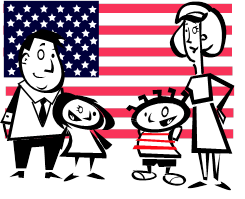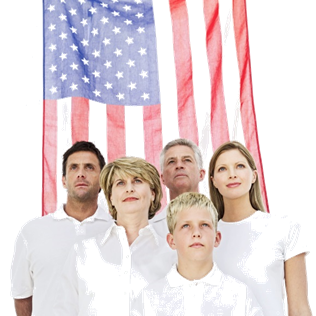
LEADERSHIP AND
CITIZENSHIP
Lesson
Overview
Whenever people are in groups, they need leaders. Leaders help the group focus on what needs to be accomplished and to move forward. With practice, you can develop good leadership skills.
|
Key Terms |
||
|
Citizen |
Citizenship |
Volunteers |
|
Service Learning |
Leadership |
Goal |
|
Short-term goal |
Long-term goal |
Fixed goal |
|
Flexible goal |
Values |
|
Citizenship
 A
citizen is a member of the community, city, state and country. As a citizen,
you have certain rights and responsibilities. The way you handle these tasks is
known as citizenship.
A
citizen is a member of the community, city, state and country. As a citizen,
you have certain rights and responsibilities. The way you handle these tasks is
known as citizenship.
The
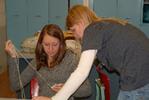
This citizen
lends a helping hand to another citizen with a problem.
Good citizenship can be learned and practiced at home. There are two main requirements: one is that you care, and the second is that you act on your caring. By showing respect to other members of your family, you are demonstrating a quality of good citizenship. Doing your share of work at home and helping others demonstrates good citizenship as does showing respect to other family members.
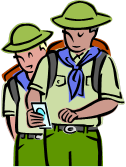 You
have probably benefited from other people acting as a good citizen. They may
have been your soccer coach, Girl Scout leader, 4-H advisor, or a volunteer at
the hospital. These conscientious citizens are concerned about the well-being
of other people. They take action to help provide for the needs of others. What can you, as a concerned citizen, do to
demonstrate good citizenship? What can you do to help someone else or to make
the world a better place? Think about the possibilities. Recently, there have
been a number of weather-related disasters. The
You
have probably benefited from other people acting as a good citizen. They may
have been your soccer coach, Girl Scout leader, 4-H advisor, or a volunteer at
the hospital. These conscientious citizens are concerned about the well-being
of other people. They take action to help provide for the needs of others. What can you, as a concerned citizen, do to
demonstrate good citizenship? What can you do to help someone else or to make
the world a better place? Think about the possibilities. Recently, there have
been a number of weather-related disasters. The
![]() Qualities
of Good Citizenship (02:45)
Qualities
of Good Citizenship (02:45)
Volunteering
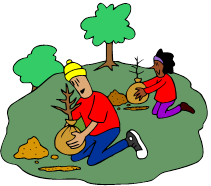 Volunteers
are regular people who do extraordinary things. They are people who assist in
the community without being paid to do so. Volunteers make a difference in the
community at places such as hospitals or parks. At hospitals, they deliver mail
or flowers to patients. In parks, they help build playgrounds, paint swing
sets, plant flowers, and rake leaves. Volunteers put caring into action. They
help because they know they are making a difference, not because they are being
paid.
Volunteers
are regular people who do extraordinary things. They are people who assist in
the community without being paid to do so. Volunteers make a difference in the
community at places such as hospitals or parks. At hospitals, they deliver mail
or flowers to patients. In parks, they help build playgrounds, paint swing
sets, plant flowers, and rake leaves. Volunteers put caring into action. They
help because they know they are making a difference, not because they are being
paid.
![]() Go to
Questions 1-8.
Go to
Questions 1-8.
The Internet is very helpful in searching for information on volunteer opportunities in your community, your country and around the world. Here are a few sites to get you started.
►American Red Cross at http://www.redcross.org/
►Anti-Cruelty Society at http://www.anticruelty.org/
►Big Brothers Big Sisters at https://www.bbbs.org/
►Habitat for Humanities at https://www.habitat.org
►National Coalition for Homelessness at http://www.nationalhomeless.org/
►Reading is Fundamental at http://www.rif.org/
►Salvation Army at https://www.salvationarmyusa.org/usn/
►Special Olympics Web site
http://www.specialolympics.org/
►United Way web site is https://www.unitedway.org/
![]() Go to
Question 9.
Go to
Question 9.
Service
Learning
Many high schools and colleges require students to become involved in service learning. Service learning is when students take action in their community and learning during the process. They apply what they are learning in a way that it helps others in their community. Schools may require service learning hours in order for students to meet graduation
requirements.
What
Is Leadership?

Leadership is a process
in guiding a group to determine their goals, make plans to achieve the goals,
and carry out those plans.
In the past, leaders
in some countries have risen to power by being born into a royal family. These
countries feel the ability to lead is inherited by a few people and the rest of
society is born to be the followers. However, history shows that hard work,
determination, and intelligence are stronger makers of leaders than heredity.
In the
Leaders have two
main purposes: they keep the group together, and see that things get done. Good
leaders do not do all the work themselves, but divide responsibilities among
members of the group.
![]() Go
to Questions 10-11.
Go
to Questions 10-11.
Characteristics of Good Leaders
 Good
leaders listen to suggestions and concerns of the group. This open
communication helps keep the group working together to accomplish more. Good
leaders build a team from the members of the group by recognizing the strengths
or talents of each member. The student who pays great attention to detail would
be a good person to put in charge of the community bazaar. Another student who
is awesome in computer skills would be good for creating flyers to advertise
the bazaar. Another student who is good with public speaking could go to the
local radio station and record Public Service Announcements (PSAs) to air on
the radio and publicize the bazaar. By capitalizing on strengths of all
members, more is accomplished than if one person were working alone. In
addition, the members take more ownership of the group when they have a part in
what is happening.
Good
leaders listen to suggestions and concerns of the group. This open
communication helps keep the group working together to accomplish more. Good
leaders build a team from the members of the group by recognizing the strengths
or talents of each member. The student who pays great attention to detail would
be a good person to put in charge of the community bazaar. Another student who
is awesome in computer skills would be good for creating flyers to advertise
the bazaar. Another student who is good with public speaking could go to the
local radio station and record Public Service Announcements (PSAs) to air on
the radio and publicize the bazaar. By capitalizing on strengths of all
members, more is accomplished than if one person were working alone. In
addition, the members take more ownership of the group when they have a part in
what is happening.
Good leaders think creatively to help reach the goals of the group. They are willing to guide the group and try new things. They do not limit their group to projects they have tried in the past because they keep open minds.
Good leaders help recognize group goals. Leaders guide their groups so goals stay in focus, and they direct the plans for the group’s activities. For example, Josef is a single dad with three children, ages 4, 6, and 10. He works as a lab technician at the local hospital. His job allows him to support his family financially and give them health insurance. Josef is the leader of his family group. The group goals include money to purchase food, clothing, and other needs of the family. Having health care is another goal of the family. Providing love and support, giving and sharing among family members would also be important. In this family group, Josef, as the adult, is providing financial support and providing for health insurance. The three children are providing support and love for one another. As the children grow and develop, they may also help with support in other ways.
Good leaders organize activities by recognizing what needs to be done and having members responsible for each facet of the project. For instance, if the group were having a spaghetti dinner as a fund raiser, the leader would recognize the needs:
o tickets for the meal
o advertising so everyone knows about the dinner
o workers to serve the food
o food to be purchased and prepared
o workers to cook the food
o clean-up during the dinner and after it is over
o money takers to sell tickets at the door
o money to make change
The leaders may organize this project into committees that might include: publicity, food, ticket, and clean-up committees. Each committee would have a list of goals or things that must be accomplished.
Good leaders handle conflicts between group members. The conflicts may arise when members have different opinions of what the group should work on or how they “go about” doing the work.
Good leaders guide groups as they make decisions. They keep the group on task by not letting them get sidetracked on other things. Using the rules of parliamentary procedure found in Roberts Rules of Order is helpful in guiding group activities. Parliamentary Procedure encourages all members to discuss topics and gives each member a vote.
Good leaders participate along with group members. Leaders do not feel they are above the other members but work with them as they labor together on their various projects.
Good leaders let other members know how much they appreciate their work for the group.
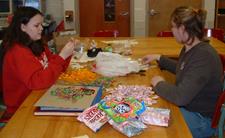
These teenagers are preparing a treat
for members of the Family, Career and Community Leaders of
Good leaders manage group resources that may include money, time, as well as other items.
![]() Go to
Questions 12-24.
Go to
Questions 12-24.
Building Leaders
Leaders have positive
self-esteem, which means they feel good about themselves. Leaders realize they
have something to offer to the group, such as organizational skills. Becoming involved
in activities they are good at and enjoy also builds self-confidence. They are
self-motivated. Other people do not need to push leaders because they motivate
themselves to make sure they meet deadlines and accomplish goals. Leaders also
have effective communication skills. Speaking in front of a group is a
communication skill that can be developed as can being a good listener.
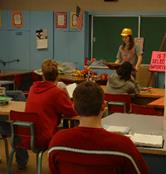
This student is learning to make presentations in
front of classmates.
Characteristics
of Group Members
Not all people will be leaders; or they may not be leaders in every situation. Without good followers, it would be hard to get things accomplished. Followers are members of the group. Everyone is a group member. The group may be your family or a group away from your home. As a group member, you can do things to make the group run more smoothly.
Group members are responsible for carrying out tasks they have been assigned or for which they have volunteered. For instance, if you said you would find the details to enter a float in the homecoming parade, you gather information and report back at the next meeting telling the group about the entry deadline, the date and time of the parade.
Group members are trustworthy and honest in handling resources of the group.
Group members work with the leader and other members of the group to accomplish the goals they have set. Group members also show respect for others in the group by listening to their views and working with them on projects.
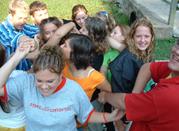
This group is trying to achieve a group goal of
untangling the human knot they have created. Will they be successful?
Group members try to get along with others in the group although they do not always agree with everyone. Listening to others and asking questions when they do not understand will be helpful.
Working together requires good teamwork. This involves working in cooperation with others in your group to achieve the group goals. Good teamwork means members of the group share values and goals. Members interact with one another and are able to achieve more than if they were working alone. Team building activities can encourage your members to work together toward common goals.
![]() Go to
Questions 25-29.
Go to
Questions 25-29.
Goals
 A
goal is something that you make an effort to achieve or work towards. It may be
something you work on by yourself or something you work on with a group such as
your family or as a member of an organization.
A
goal is something that you make an effort to achieve or work towards. It may be
something you work on by yourself or something you work on with a group such as
your family or as a member of an organization.
There are different kinds of goals. A short-term goal is one that can be achieved in a short period of time. An example is painting your room. Long-term goals take longer, six-months or more, six months or more. An example is graduating from college. This may seem like an impossible task, but if you divide it into smaller goals, it much easier. For instance, you might start with a short-term goal of taking 15 hours for the fall term at college.
Goals can also be divided into fixed and flexible goals. Fixed goals must be met by a certain date. For example, to graduate from high school, you may have to complete all courses by June 10. The time deadline with fixed goals is usually determined by someone else, and you have little or not control over the timelines. Flexible goals have no definite time limits. For example, a goal to someday get your pilot’s license is flexible. Fixed and flexible goals may be either short-term or long-term.
Setting
Goals
Your values, or what is important to you, guide the goals you pursue. If your health is important, you may set a goal of running a mile. If appearance or beauty is important to you, you may have an elaborate flower garden in your back yard.
Writing a goal on paper helps you to focus on it. Putting the written goal in a location where you will see it often, like on the bathroom mirror, will also help you concentrate on reaching it.
Be specific about your goal. Write it so you will be able to measure it and determine if you have achieved it. Saying I want to run faster, leaves questions. Run faster than what? Run faster than your two year old brother? Run faster than a train? To make this clearer, you might list your goal as to being able to run one mile in nine minutes. This can be measured. Did you run one mile? How long did it take?
Completing all your goals may be impossible; therefore, it may become necessary for you to prioritize your goals. This means deciding which ones are more important than others.
Goals should be challenging but not overwhelming. In other
words, they need to be realistic. Setting a goal of becoming president of the
Examine the resources you need to reach your goal. If your goal if to run one mile in nine minutes, you will need a safe place to run, good running shoes, comfortable clothes, and eventually a stop watch to check your time.
![]() Go to
Questions 30-37.
Go to
Questions 30-37.
What goals will you accomplish in the future?
![]() Go to
Questions 38-39.
Go to
Questions 38-39.
 |
| Unit 7 Leadership and Citizenship (Fill in the Blank) Worksheet |
| Unit 7 Leadership and Citizenship (Advance Organizer) Worksheet |
